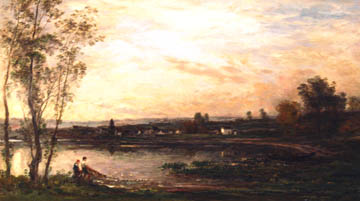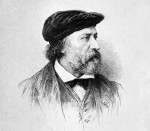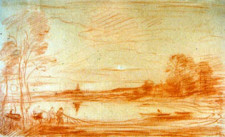
Charles Francois Daubigny
French, 1817-1878
Les Pecheurs (The Fishermen), n.d.
oil on panel
SBMA, Museum Purchase Suzette and Eugene Davidson Fund
1988.1

Portrait Of Daubigny by Leopold Massard
RESEARCH PAPER
INTRODUCTION
"Les Pecheurs" (The Fishermen) is an Oil on Panel painting of 1868 dated and signed on the lower right by French painter, Charles Francois DAUBIGNY. No conservation records are contained in the curatorial file. The painting was purchased by the museum early in 1988 through the Suzette and Eugene Davidson Fund from Stoppenbach and Delestre, Ltd., London, having been previously owned by four private dealers or individuals.
DAUBIGNY can be classed in that group of painters known as the Barbizon School, so called because they brought landscape painting from the Romantic or imaginary subject matter of Claude Poussin to scenes of contemporary rural life using straight forward, objective compositions and working in the small villages surrounding Paris, such as Barbizon on the edge of the forest of Fountainebleau. These artists, in contrast to the academic painters of the day, spent long hours sketching and painting outdoors, although most of the canvases were finished in their studios.
THE ARTIST
Charles Francois DAUBIGNY was born February 15, 1817 and came from a family of artists; his father, Edme, a salon painter, started him painting decorative objects at an early age; his aunt, Uncle Pierre, and older sister all adept at miniature portraits. As a sickly infant, he was sent to be nursed in the small village of Valmondois, which instilled in him his love of the countryside and was the subject of many a later painting.
As all serious painters of the time, he dreamed and saved for a number of years to make a journey to Italy, which he took with Henri Mignan in 1835, walking most of the way there and back. On his return to Paris in 1836, he worked on the restoration of the paintings in the Louvre under Granet and spent six months apprenticing for the famed Prix de Rome with the popular Romantic painter, Paul Delaroche. However, his principal means of support during those early years was his prolific work as an etcher-illustrator. Although most of his early salon paintings are lost, we still have the etchings made from them.
The revolution of 1848, which toppled the monarchy of Louis-Philippe, freely permitted artists dedicated to naturalism in landscape to flourish. In 1852 the State purchased DAUBIGNY's "View of the Seine", followed by the subsequent purchase of the "Pond of Gylieu" in 1853 by the Emperor, thereby establishing his reputation and assuring his financial security. In 1857 he purchased and outfitted a small barge, "Le Botin", as a floating studio, leading him for the next 20 years to wander along the banks of the Seine, Oise and other rivers of France perfecting his extremely individual and creative eye for landscapes. That same year he received the Legion of Honor and his successes led him to be nominated as a Salon judge in 1865. However, his encouragement of the young Impressionists led him to resign this important position in 1870.
Little is known of his wife, Sophie-Marie, whom he married in 1842, but he was obviously close to 2 of his 3 children; Karl-Pierre, who followed in his father's footsteps as a landscape artist, exhibiting their paintings side by side in the salons and much is made of the charming room he and his artist friends decorated for his beloved daughter, Cecile, in the house in Auvers, where he maintained a home over the years.
THE PAINTING
Set on the banks of a small, un-named river, this typical DAUBIGNY landscape was done in 1868 when the artist was at the height of his career - member of the Salon jury, both criticized and acclaimed by the art critics, and travelling and exhibiting his works throughtout France.
The delineation of the painting is obvious, with the foreground being the fishermen along the banks of the river, the middle ground anchored firmly by the strorg horizontal line of the village and the background is given over to the frothy, light-filled clouds reflecting the setting sun.
The overall composition has a calming effect provided by this horizontal line of houses which first draws our attention, then the natural oval of the river leads our eye around and down to the focal point of the fishermen at the bank, who themselves, short vertical lines of relief, are backed by the strong vertical stance of the trees on the left. Only a gentle action is implied by the short diagonal of the nets being pulled in and the delicate lapping of the waves against the reed-filled bank.
The Impressionists were not the first painters to try to capture the ethereal, reflective qualities of light. Throwing all forms up into dramatic relief was a device typical of DAUBIGNY's inventive concepts. He preferred the moments of dramatic change - the approach of a storm, the sunrise and sunset, the sun glowing on water. 1 This technique is evident in the arresting play of light from the setting sun through the trees on the left, shining brilliant white on the houses, tips of the waves and bobbing nets. This reflective light against the frothy, pale clouds and patches of blue sky also provides the painting with it's almost only variation in the somber, earthy but verdant coloration.
CONCLUSION
In defense against recent criticism, an indifferent public and flagging sales just before his death in 1878, the art critic, Castagnary, said of Charles Francois DAUBIGNY that his "... is not color spread on a canvas with a brush, it is light stolen by the artist from the vital sources where nature creates the day." 2
Barbizon art and it's principal artists, such as Daubigny and his friend and mentor Camille Corot, must not be seen as merely the bridge or cradle of Impressionism, but as an important movement on it's own merits which brough art from it's lofty Salon domain to the real heart of France - it's countryside, rivers, villages and common man.
1 William Weston Gallery, Five Masters of the Barbizon School Catalogue 2, 1976.
2 Fidell-Beaufor, etc. DAUBIGNY La Vie et L'Oeuvre Editions Geo roy-Dechaume, 1975.
Prepared for the Santa Barbara Museum of Art Docent Council by Mimi Forbes
May 1989
BIBLIOGRAPHY
BOOKS
1. Fidell-Beaufort, Madeleine and Bailly-Herzberg, Janine. _Daubigny, La Vie et L'Oeuvre. Editions Geoffroy-Dechaume, 1975 Kent State University Press
2. Henriet, Frederic. Charles Daubigny et son Oeuvre Grave. Paris, 1875.
PERIODICALS
1. Time Magazine. "The Voices of the Trees", December 14, 1962.
EXHIBITION AND COLLECTION CATALOGUES
1. Herbert, Robert L. Barbizon Revisited. Museum of Fine Arts and Yale University. 1962.
2. Gregg, Richard N. 1st American Retrospective Exhibit of C.F. Daubigny. Paine Art Center, Oshkosh, Wisconsin
May 1-31, 1964.
3. Fuller, W.H. 2 Barbizon Painters. Union League Club of New York, 1895.
AUCTION CATALOGUES
1. Goodfriend, C and J. Eaux-Fortes par Daubigny. New York
2. William Weston Gallery. Five Masters of the Barbizon School. Catalogue #2, 1976.

Figures Pulling in Nets, 1865, 1988.16 - The Santa Barbara Museum of Art is fortunate to have purchased in May of 1988 from Christie's, New, York, a red chalk study made by DAUBIGNY for "Les Pecheurs". It is truly amazing to see his obviously quickly drawn, long pencil strokes transformed into the short, decisive and rapidly applied brush strokes of this fine example of a Barbizon painting.
